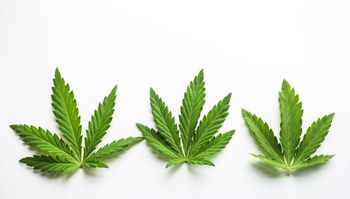
Cannabis Science and Technology
- November/December 2018
- Volume 1
- Issue 4
Rapid Screening of Cannabinoids in Edibles Using Thermal Desorption-GC–MS
A look at how TD-GC–MS analysis eliminates conventional sample preparation regimes and can be used as a good rapid screening technique.
Most of the traditional methodologies for the determination of cannabinoids are based on solvent extraction, filtration, and concentration. These techniques are cumbersome, time-consuming, and suffer from analyst-to-analyst variability while producing data of limited value. Many laboratories routinely “screen” each sample to quickly determine the potential for matrix interference and instrument contamination while providing an estimate of the target compound’s concentration. A good “screening” method is simple (that is, minimal or no sample preparation), fast (analysis in less than 5 min), and semiquantitative. This article describes how thermal desorption (TD)-gas chromatography–mass spectrometry (GC–MS) analysis eliminates conventional sample preparation regimes and can be used as a good rapid screening technique.
Most of the traditional methodologies for the determination of cannabinoids are based on solvent extraction, filtration, and concentration. These techniques are cumbersome, time-consuming, and suffer from analyst-to-analyst variability while producing data of limited value.
As the demand for the analysis of cannabinoids increases, it is imperative that the day-to-day analytical protocols be reproducible, accurate, and efficient. Many laboratories routinely “screen” each sample to quickly determine the potential for matrix interference and instrument contamination while providing an estimate of the target compound’s concentration. A good “screening” method is simple (that is, minimal or no sample preparation), fast (analysis in less than 5 min), and semiquantitative.
One of the most widely used analytical techniques for “screening” is thermal desorption-gas chromatography–mass spectrometry (TD-GC–MS) (1,2). This technique does not require any solvent extraction or sample pretreatment. Milligram quantities are put in an inert sample cup which is then “ready to analyze.” The multimode pyrolyzer with a vertical micro-furnace design allows programmable and multiple thermal desorption analysis on a single sample. This process, which refers to evolved gas analysis (EGA), starts with the acquisition of a thermal profile (that is, detector response as a function of sample temperature) of each sample type. To perform EGA, a short, deactivated tube (2.5 m, 0.15 mm i.d.) is used to connect the injection port to the MS detector. The sample is dropped into the furnace at a relatively low temperature (40–100 °C). The furnace is then programmed to a much higher temperature (600–800 °C). Compounds “evolve” from the sample as the temperature increases. A plot of detector response versus furnace temperature is obtained. Extracted ion chromatograms (EIC) are used to identify the thermal zone over which specific compounds of interest evolve from the sample. Now, these optimum TD temperatures can be used in subsequent TD-GC–MS experiments to introduce the key components of interest while minimizing introduction of the matrix. Only this portion of the sample is actually transferred (that is, injected on) to the analytical column. Injecting only a small portion of the sample provides immediate benefits to the laboratory, such as:
- The high boiling fraction of the sample remains in the sample cup. This eliminates the need for a high-temperature bake out. Thus, column lifetime increases, there is little to no system contamination, and run-to-run cycle time decreases.
- More sample can be put in the sample cup, which has the effect of lowering detection limits-without affecting instrument performance or cycle time.
With respect to the analysis of cannabinoids, it is important to keep in mind that TD-GC–MS is based on the volatilization of target compounds from the matrix. Those compounds that are thermally labile or easily converted to an alternative compound need to be identified. In these instances, it is the reformed compounds that are identified and monitored. Decarboxylation is forced to completion which could give the “screening determinations” higher values: the concentration range increases and dilution factors are more accurately determined.
Experimental
Three edible samples were analyzed using the TD-GC–MS method for quantification of cannabinoids. The experiments were performed by a Frontier Multi-Mode Pyrolyzer (EGA/PY 3030D) directly interfaced to a benchtop GC–MS system. To automate the sequence and reduce the workload by increasing reliability of analysis, the Auto-Shot Sampler (AS-1020E) was combined with the multimode pyrolyzer. The vent-free GC–MS adaptor that allows switching of a GC separation column without breaking vacuum on the MS detector was also used. The adaptor was utilized for switching the EGA tube to the separation column and vice versa without venting the MS detector, which saves time and increases productivity.
Sample 1
A commercial package of cannabis-infused chocolate brownie containing 10 brownie bites with the total of 100 mg tetrahydrocannabinol (THC) was used. According to the product label, each brownie bite contains 10 mg of THC. In this experiment, one of the brownie bites from the package was placed on an analytical balance, and the weight was recorded as 10.17 g. So, based on the label, there is 10 mg/10 g = 1 mg/g of THC present in that brownie bite. The same brownie bite with the recorded weight was used to perform the TD-GC–MS analysis to confirm the theoretical THC value according to the label.
To calculate and confirm the amount of THC, EGA was first performed on a THC standard (Absolute Standard). The pyrolyzer furnace was programmed from 100 °C to 800 °C (20 °C/min), and the EGA thermogram as shown in Figure 1 was obtained. (See upper right for Figure 1, click to enlarge. Figure 1: EGA thermogram of THC standard and extracted ion chromatograms (EICs).)
From the EGA thermogram, the optimal thermal desorption zone of THC was identified as 100 °C to 300 °C. In fact, using the MS interpretation library, the peak with the apex of 185 °C (100 °C to 300 °C temperature zone) was identified as THC. TD-GC–MS analysis was then performed on the brownie bite in triplicate as shown in Figure 2. (See upper right for Figure 2, click to enlarge. Figure 2: TD-GC–MS chromatograms of the brownie bite in triplicate.) To perform TD-GC–MS analysis, the pyrolyzer furnace was programmed from 100 °C to 300 °C (100 °C/min) after the EGA tube was replaced by a separation column (easily facilitated by using the vent-free GC–MS adaptor). The amount of sample used to obtain the TD chromatograms was 0.25–0.26 mg.
The peak shown in Figure 2 (noted with a *) between the retention time of 12 to 14 min was identified as THC using the MS interpretation library. The percent relative standard deviation (RSD%) of 4.6% was calculated based on the area counts of the THC peak. The most intense peak around 6 min was identified as 5-hydroxymethylfurfural (dehydration of sugar).
To confirm the THC concentration in the brownie bite, a standard addition calibration curve was created. The standard solution was a mixture of cannabidiol (CBD), THC, and cannabinol (CBN). Figure 3 shows the calibration curve and calculated amount of THC in the brownie bite. (See upper right for Figure 3, click to enlarge. Figure 3: Edible (brownie) sample standard addition calibration curve.)
Using the calibration curve, the THC concentration is calculated as 0.996 mg/g while the product label indicates 1 mg/g of THC.
Sample 2
A commercial cannabis-infused dark chocolate bar with the total of 100 mg THC and net weight of 50 g (1.7 oz) was used for sample 2. According to the product label, there are 20 pieces of chocolates and each piece of chocolate contains 5 mg of THC, so there is 100 mg/50 g = 2 mg/g of THC present in each piece. To demonstrate the accuracy and precision of the methodology, the analysis was performed in triplicate. The weights of each piece were recorded using an analytical balance as 0.099 mg, 0.097 mg, and 0.105 mg.
The same methodology was used for analyzing sample 2. First, the EGA was performed as the fast rapid screening technique. Then the optimal thermal desorption zone of THC was identified. The pyrolyzer furnace was programmed from 100 °C to 300 °C (100 °C/min) to obtain the thermal desorption chromatograms for all three pieces of the chocolate. Figure 4 shows the TD chromatograms in triplicate. (See upper right for Figure 4, click to enlarge. Figure 4: TD-GC–MS chromatograms of the chocolate pieces in triplicate.)
The peak shown in Figure 4 (noted with a *) between the retention time of 12 to 14 min was identified as THC using the MS interpretation library. The RSD% of 4.6% was calculated based on the area counts of the THC peak.
To confirm the THC concentration in the chocolate pieces, a standard addition calibration curve was created. The standard solution was a mixture of CBD, THC, and CBN. Figure 5 shows the calibration curve and calculated amount of THC in the pieces. (See upper right for Figure 5, click to enlarge. Figure 5: Edible (chocolate pieces) sample standard addition calibration curve.)
Based on the calibration curve, the THC concentration is calculated as 2.1 mg/g while the product label indicates 2 mg/g of THC.
Sample 3
A commercial cannabis-infused gummy package with the net weight of 45 g (1.59 oz) was used for sample 3. The package contains 10 gummies with THC and CBD (2-[(1R,6R)-6-isopropenyl-3-methylcyclohex-2-en-1-yl]-5-pentylbenzene-1,3-diol). According to the product label, each gummy has 10 mg CBD and 5 mg THC. The label also indicates that tetrahydrocannabinolic acid (THCA), cannabidiolic acid (CBDA), and CBN (other required cannabinoids) are 0.0 mg/package.
To perform the TD-GC–MS analysis, one of the gummies was weighed on an analytical balance The weight was recorded as 0.109 mg. The sample was then placed in MeOH and sonicated for 1 h. Next, 1 µL of MeOH solution was spiked into the sample cup.
It is important to mention that the gummy sample could be analyzed as is without dissolving in any solvent. The experiment on sample 3 was performed based on external standard calibration to demonstrate the reliability and flexibility of this technique.
Figure 6 shows the TD-GC–MS chromatograms of the gummy samples in triplicate. (See upper right for Figure 6, click to enlarge. Figure 6: TD-GC–MS chromatograms of the gummy in triplicate.) The EGA thermogram of the gummy confirmed the thermal zone of 100 °C to 300 °C for both THC and CBD. Note the detection peaks of both CBD and THC in the chromatograms. The RSD% of 2.5% for CBD and 2.3% for THC are calculated based on the area counts of the THC peak.
To confirm the THC and CBD concentrations in the gummy sample, an external standard calibration curve was created. Figure 7 shows the calibration curves and the calculated concentrations, which are in excellent agreement with the package label. (See upper right for Figure 7, click to enlarge. Figure 7: Edible (gummy) sample external standard addition calibration curve.) CBD concentration is calculated as 8.5 mg/gummy compared to the label value of 10 mg/gummy. The calculated THC is 6.1 mg/gummy while the label indicates the value of 5 mg/gummy.
Conclusion
Table I shows the calculated and label values of the cannabinoid concentrations in all three commercial edible samples. (See upper right for Table I, click to enlarge. Table I: Summary of the theoretical and calculated cannabinoids in the edibles.) Using TD-GC–MS the cannabinoids were thermally extracted from the mixture and the calculated concentrations were in excellent agreement with the package labels. Standard addition calibration curves were used for the brownie bite and chocolate piece while an external standard calibration curve was created to calculate THC and CBD in the gummy sample.
In conclusion, thermal desorption analysis eliminates conventional sample preparation regimes; the sample is heated to the point that the cannabinoids desorb from the edible matrix (thermal extraction). It is fast, uses minimal or no solvent, and eliminates the need for expensive glassware. TD-GC–MS is a “volatiles only” analysis; high boiling sample constituents remain in the sample cup which eliminates system contamination, increases system stability, and reduces run-to-run analysis time.
A multimode pyrolyzer provides users with a clear picture of the sample’s composition by identifying the thermal zones and the compounds in each zone. Using the EGA thermogram, one can simply determine the suitable temperature program and program the pyrolyzer’s furnace appropriately.
Using pyrolysis GC–MS, solid samples can be analyzed. There is no solvent required when using pyrolysis-thermal desorption GC–MS as opposed to traditional GC–MS techniques. In other words, the solid and liquid samples can be injected (using an inert sample cup) into the pyrolyzer without any solvent and sample pretreatment. This advantage, as well as rapid screening capability, is one of the primary reasons many laboratories integrate multimode pyrolyzers into both their day-to-day quality control and analytical research protocols.
Pyrolysis GC–MS techniques also enable material characterization of virtually any organic material by providing detailed information about the composition of the samples. This technique is used for identification of complex polymers, copolymers, volatiles, and additives as well as failure, contamination, deformulation, and degradation analyses. As opposed to GC–MS alone, pyrolysis GC–MS allows multiple and customized analysis on the same sample while the MS libraries offer a broad range of references: from low boiling point compounds to pyrolyzates and heavier polymeric fragmentations. In terms of the ability to run samples at higher temperature, pyrolysis GC–MS can provide the user with an expanded temperature range from ambient +10 to 1050 °C (± 0.1 °C precision) as well as a high interface temperature (maximum 450 °C).
Acknowledgement
The authors thank Robert Freeman, Itsuko Iwai (Research & Development, Frontier Laboratories), and Terry Ramus (application scientist, Diablo Analytical) for contributing to the article and providing the analytical work, without which this article would not have been possible.
References:
- ASTM International, ASTM D7823-16: Determination of Low Level, Regulated Phthalates in Poly (Vinyl Chloride) Plastics by Thermal Desorption-Gas Chromatography/Mass Spectrometry,
https://www.astm.org/Standards/D7823.htm . - International Electrotechnical Commission, IEC 62321-8: Determination of certain substances in electrotechnical products – Part 8: Phthalates in polymers by gas chromatography-mass spectrometry (GC-MS), gas chromatography-mass spectrometry using a pyrolyzer/thermal desorption accessory (PY/TD-GC-MS),
https://webstore.iec.ch/publication/32719 .
Rojin Belganeh is the technical and marketing director for Frontier Laboratories Ltd. North America in Antioch, California. William Pipkin is the president of ATRq in Orem, Utah. Direct correspondence to:
How to Cite This Article
R. Belganeh and W. Pipkin, Cannabis Science and Technology1(4), 50-55 (2018).
Articles in this issue
about 7 years ago
Certified Reference Material Manufacturing Challengesabout 7 years ago
Error, Accuracy, and Precisionabout 7 years ago
Supplier Profiles: Other Servicesabout 7 years ago
Supplier Profiles: Manufacturing and Processingabout 7 years ago
Supplier Profiles: Cultivation/GrowingNewsletter
Unlock the latest breakthroughs in cannabis science—subscribe now to get expert insights, research, and industry updates delivered to your inbox.





